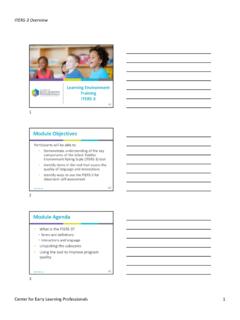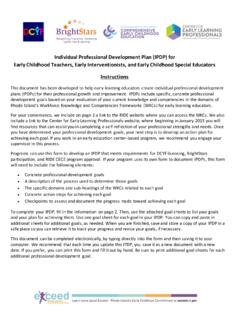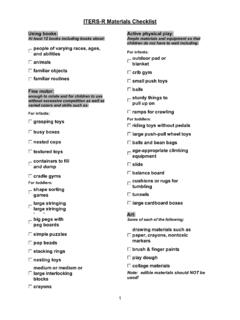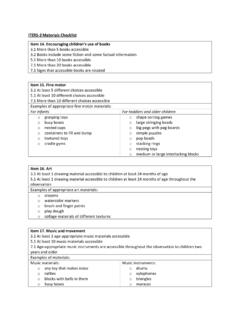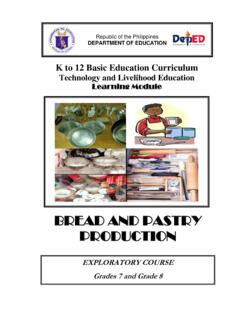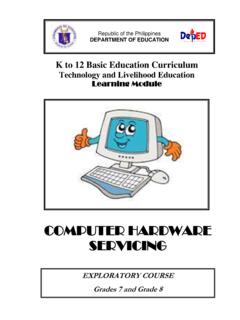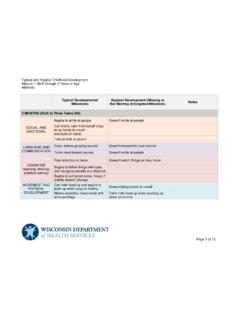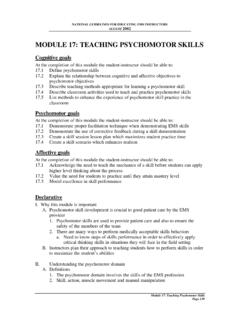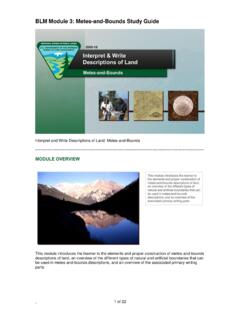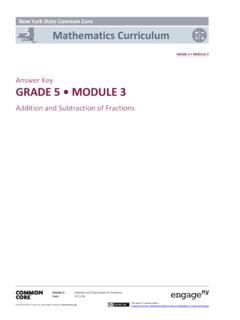Transcription of Learning Environment Training: ECERS-3 - Center for Early ...
1 Learning Environment training : ECERS-3 ModuleCenter for Early Learning Professionals1 Learning Environment ObjectivesParticipants will be able to: Demonstrate knowledge of the key components of the Early Childhood Environment Rating Scale ( ECERS-3 ) tool Identify key concepts, terms, and definitions in the tool Identify ways to use the ECERS-3 for program self-assessment and continuous quality Agenda Overview and background of the tool Reviewing important terms and concepts Unpacking the subscales Using the tool to improve program quality3 Learning Environment training : ECERS-3 ModuleCenter for Early Learning Do You Measure Quality?
2 RegulationsStandardsAssessment of ECERS-3 in Rhode Base Research evidence from relevant fields: health, education, and development Professional views of best practice Overall quality to promote children s development6 Learning Environment training : ECERS-3 ModuleCenter for Early Learning Does the ECERS-3 Measure?7 What children directly experience Interactions How materials and space are used Accessibility Daily schedule and routinesPhoto Credit: Education Development Center (EDC) Scale1 2 Inadequate 3 4 Minimal 5 6 Good 7 Excellent 8 Children might be at riskMeets basic health & safetyDevelopmentally appropriateEnhanced developmental Levels Minimal Quality Level: sometimes, few, some attempts Good Quality Level: Frequently, many Excellent Quality Level: Many, consistent, regular practice, intentional focus9 Learning Environment training .
3 ECERS-3 ModuleCenter for Early Learning in It is the average total score that is related to positive child development, but not any of the single requirements by themselves. All About the ECERS-R, p. xii AND Score each item individually Consider only what happens during the 3-hour observation Item scores range from a 1 to a 7 Start at the 1s and progress upward12 Learning Environment training : ECERS-3 ModuleCenter for Early Learning Quality Improvement, Not Perfection The scales assist program staff to make well-informed choices as to which areas the staff might emphasize in program improvement.
4 It is not required that all things be Debby Cryer, Understanding the Meaning of Environment Rating Scale Scores Components of the ECERS-3 Designed for use for ages 3 5 Reliance on observation of ongoing classroom activity Uses the 3-hour observation only to base Components of the ECERS-3 Large focus on interactions and teacher s role-20 items Emphasis on language, literacy, and math Heavy focus on howteachers support children s use of classroom materials15 Learning Environment training : ECERS-3 ModuleCenter for Early Learning Terms Observed schedule Accessible Engaged Hand hygiene Individualized teaching Play area and interest Center Sanitizing and disinfecting Staff Teaching Usually and generally Weather Schedule A continuous 3-hour block of time Begins during the most active part of day, when most children have arrived Only what is observed during that period will be used to determine scores The written schedule is not used to can reach and use materials, furnishings.
5 And equipment withno barriersWhat might be some barriers?18 Learning Environment training : ECERS-3 ModuleCenter for Early Learning It Accessible? and Time At the minimal quality level, children must have access for 25 minutes At thegood quality level, children must have access for 1 hour Gross motor space and equipment: At minimal quality level, for 15 minutes At good quality level, for 30 Area vs. Interest CenterAll interest centers are play areas, play areas are NOT interest centers. Play Area: a space where play materials are provided for children Interest Center : a clearly defined play area for a particular kind of play21 Learning Environment training : ECERS-3 ModuleCenter for Early Learning Centers22 Photo Credit: Education Development Center (EDC) Space & Furnishings Personal Care Routines Language & Literacy Learning Activities Interaction Program and Furnishings7 Items.
6 Indoor space Furnishings for care, play, and Learning Room arrangement for play and Learning Space for privacy Child-related display Space for gross motor play Gross motor equipment24 Learning Environment training : ECERS-3 ModuleCenter for Early Learning 3: Room arrangement for play and Motor Space & EquipmentItem 6: Space for gross motor play Outdoor and indoor spaces Enough space for running At least 30 minutes (good quality level)Item 7: Gross motor equipment Equipment stimulates at least 7 different skills Access for 30 minutes (good quality level) Helmets required for wheel toys (highest quality level) 5: Child-related display Display is: Children s individualized artwork Related to children ( , rules, helper jobs) Related to current topics and interests Staff: Talk about display in ways that interest children Use display to encourage informal conversations Point out and read the words in the display27 Learning Environment training .
7 ECERS-3 ModuleCenter for Early Learning Display Example28 Photo Credit: Education Development Center (EDC) Care Routines Subscale4 Items: Meals/snacks Toileting/diapering Health practices Safety and Literacy Subscale5 Items: Helping children expand vocabulary Encouraging children to use language Staff use of books with children Encouraging children s use of books Becoming familiar with print30 Learning Environment training : ECERS-3 ModuleCenter for Early Learning 15: Encouraging children s use of books Easy access and time Wide selection of books Reading interest Center Children show interest in books31 Photo Credit: Education Development Center (EDC) 14: Staff use of books with children Book reading must happen (large or small group, or individually).
8 Staff show interest and enjoyment in reading. Children are engagedduring reading. Staff use books book reading part of theclassroom culture? Activities Subscale11 Items: Fine motor Art Music and movement Blocks Dramatic play Nature/science Math materials and activities Math in daily events Understanding written numbers Promoting acceptance of diversity Appropriate use of technology33 Learning Environment training : ECERS-3 ModuleCenter for Early Learning Practices Need access for at least 1 hour during the observation. Access impacts mostLearning Activities items.
9 Children need to use Learning Activities materials. Interactions are assessed in most 23: Math materials and activities Three categories of math materials: Counting/comparing numbers Measuring/comparing sizes and parts of wholes Familiarity with shapes Teacher interactions Use of fingers to 24: Math in daily events Mathematize! Math talk is used throughout the day: Daily routines Play with non-math materials/areas Large group times Encourage reasoning Environment36 Learning Environment training : ECERS-3 ModuleCenter for Early Learning 25: Understanding written numbers Math materials with numbers and pictures Signs with quantities for play areas Play materials with numbers (telephones, play money, puzzles) Teacher interactions Teachers model and show children how to use.
10 Progression of QualityMinimal QualityGood QualityExceptional Quality Staff solve problems when they arise Staff have positive involvement with children using materials Staff are responsive to children's needs Staff show interest when children use materials Staff have many conversations about children's play Staff positively encourage children's participation Staff use comments and questions to expand knowledge of concepts and words Staff write children's words Staff encourage problem-solving Staff point out math or language concepts and talk about print and Closer Look at Interactions39 Photo Credit: Education Development Center (EDC) Learning Environment training : ECERS-3 ModuleCenter for Early Learning Closer Look at Interactions Stop for a moment and say, Wow!
